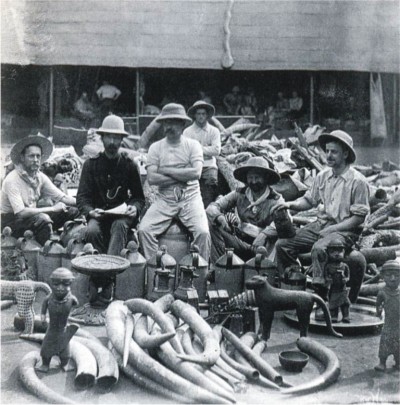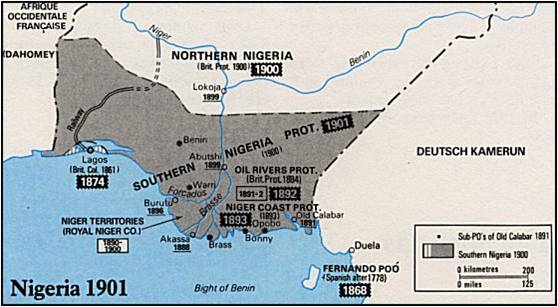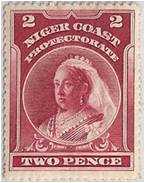ALBUM – View my Niger Coast Protectorate album
TRANSITION CHART for the British Nigeria area
Fast Facts
Region: West Africa
Group: British Nigeria
Classification: Colony (British)
Prior Regime: Oil Rivers Protectorate
Key Dates:
1862, January 1 – Lagos Island is annexed as a colony of Britain
1885 – Nigeria territory confirmed at the Conference of Berlin
1885 – Oil Rivers Protectorate proclaimed by the British after they had defeated King Jaja of Opobo
1893, May 12 – Oil Rivers Protectorate expanded and renamed Niger Coast Protectorate
1900, Jan 1 – Southern Nigeria Protectorate formed by joining Niger Coast Protectorate with territories from the Royal Niger Company
1906 – Lagos became part of Southern Nigeria
1914, Jan 1 – Southern Nigeria and Northern Nigeria were combined to form the colony of Nigeria
Following Regime: Southern Nigeria Protectorate and Northern Nigeria Protectorate
Scott Catalogue: (Niger Coast Protectorate) #7-63
Pick Catalogue: none
History

As the Germans began to flex their colonial muscles by annexing Togoland and Cameroon, the British and the French realized that decisive action was required before they started losing their territory. Therefore, a major Conference in Berlin was held in 1885 where the major European powers carved up Africa for colonization, thus, with the exception of Ethiopia and Liberia, all of Africa was to be ruled by the Europeans. In this agreement, Britain was given the area of Nigeria.
After the Berlin Conference, Britain formalized the Oil Rivers Protectorate, which included the Niger Delta and extended eastward to Calabar, where the British consulate general was relocated from Fernando Po. The primary purpose was to control trade coming down the Niger River. As a protectorate, the new territory didn’t have the full status of a colony, but remained under the jurisdiction of the Foreign Office.
The expansion into the territory was a series of diplomatic treaties and bloody battles, which ultimately subdued most of the local tribes. In August 1891, the British Government established a Consular Administration over the Oil Rivers Protectorate, consisting of six consular river districts.
 In 1893 the territory was renamed Niger Coast Protectorate, and expanded to include the region from Old Calabar to Lagos Colony and Protectorate, and northward up the Niger River as far as Lokoja, the headquarters of the Royal Niger Company.
In 1893 the territory was renamed Niger Coast Protectorate, and expanded to include the region from Old Calabar to Lagos Colony and Protectorate, and northward up the Niger River as far as Lokoja, the headquarters of the Royal Niger Company.
In the early 1890s, the Kingdom of Benin was resisted British increasing British pressure to become colonialized. In 1896, the Kingdom of Benin halted the trade and supply palm oil. The trade embargo brought trade in the Benin River region to a standstill, and British trading firms quickly appealed to the Protectorate’s Consul-General and in Jan 1897, a military force disguised as a trading negotiation commission was sent to bring down Benin. The ruse was discovered and the forces were ambushed and only two officers survived. Outraged at their defeat, Rear-Admiral Harry Rawson led a force of 1200 British Marines, sailors and Niger Coast Protectorate Forces called the “Benin Punitive Expedition”. Rawson’s troops captured, burned, and looted Benin City, bringing to an end the Kingdom of Benin. As a result much of the country’s art, including the Benin Bronzes, was either destroyed, looted or dispersed. Benin became part of the Niger Coast Protectorate.
As development proceeded in Nigeria, it soon became obvious that the practice of managing territories through chartered companies could no longer compete with the Government run colonies of the French or Germans. Therefore, the Britain canceled the charter for the Royal Niger Company for the sum of £865,000 and rights to half the mining revenue for 99 years. On 1 Jan 1900, the territories of the Niger basin including the Niger Coast Protectorate were consolidated and the Protectorates of Northern Nigeria and Southern Nigeria were formed.
Stamps
 ALBUM
ALBUM
Postal service in the region was established in the Oil Rivers Protectorate when the main post office was established at Calabar in November 1891 with sub-offices developed at Benin, Bonny, Brass, Opobo, and Warri. Initially postage stamps of Great Britain were used, but in July 1892, 6 British stamps were overprinted “BRITISH / PROTECTORATE / OIL / RIVERS” and issued.
After the change over to the Niger Coast Protectorate, there was an urgent need for halfpenny values which resulted in a variety of surcharges on 2d and 2-1/2d stamps in Sept 1893. While most simply read “HALF / PENNY”, with a horizontal bar to obliterate the old value, some were overprinted “1/2 d” twice, with the intent that they be bisected diagonally to produce two 1/2d stamps.
As the transition to Niger Coast Protectorate was occurring, new stamps were being prepared in London. The first issues for the Niger Coast Protectorate which featured a 3/4 portrait of Queen Victoria, has the inscription “OIL RIVERS” obliterated and was overprinted “NIGER COAST”. Six denominations were issued.
The following year in May of 1894, new designs inscribed correctly “NIGER COAST PROTECTORATE” were issue and featured the same portrait of Queen Victoria. These stamps were issued on unwatermarked paper. Also in 1894, there was an expanded need for 1/2d and 1d stamps and 1d and 2d stamps were overprinted to all bisection of the stamps.
In 1897, the stamps were reissued with the addition of a 2sh6p denomination on paper with the Crown and CA watermark (Scott watermark #2). The next year, in 1898 an additional 2 denominations (6d and a huge 10sh) were issued.
The stamps of Niger Coast Protectorate were superseded in Jan. 1900, by those of Northern and Southern Nigeria. One final note, in 1902 there was a temporary shortage of stamps in Southern Nigeria and remainders of Niger Coast Republic stamps of 1897/8 stamps were used.
Banknotes
British currency was used
Links
Colonial Nigeria from Wikipedia
The Origin of Sapele Township from the Journal of the Historical Society of Nigeria
Stamps of Colonial Nigeria at Stamp Collecting Blog
Oil Rivers Protectorate Stamps – GB Overprints Society




